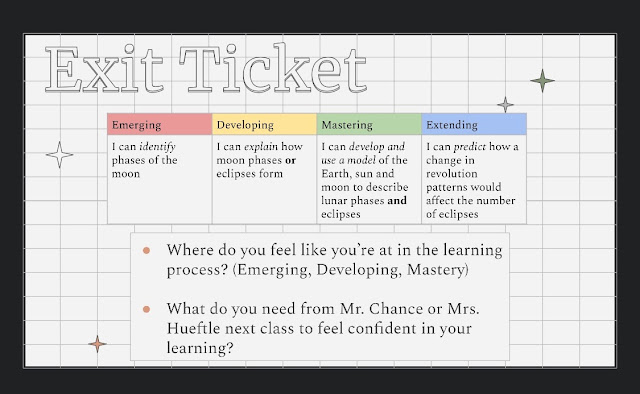
Your Ticket to More Effective Lessons
For the duration of my schooling to grow to be a instructor, I was immersed in the work of Madeline Hunter when it came to lesson system style and design. Her Instructional Principle into Observe (ITIP) product helped me determine the procedures I would use on a everyday foundation to enable my pupils discover. These involved the anticipatory set (hook), examining prior finding out, examining for comprehension, kinds of exercise, and closure. Each individual lesson had these things and I normally received good feed-back from directors on these when they observed me. Closure is something I was amazingly proud of and I constantly ended classes with some kind of paper exit ticket. I shared the subsequent in Disruptive Pondering:
Even though the opening moments with learners are important, so are the closing minutes. Believe about this for a second. What is the position of an objective or understanding target, whether mentioned, on the board, or pupils obtaining the opportunity to discover for them selves, if there is no option at the stop of the lesson to ascertain if it was attained? Discovering increases when classes are concluded in a manner that aids students organize and don’t forget the level of the lesson.
At the time, this design was both equally a realistic and effective means for planning immediate instruction and was commonly embraced as this was the major tactic utilized in lecture rooms. It streamlined methods in an successful way that could be replicated working day in and working day out. Herein lies the major drawback of ITIP. It was a a person-size-fits-all tactic centered on the instructor building all the conclusions from an instructional standpoint at the price of establishing skilled learners who can think.
Like numerous factors in schooling, aspects of ITIP even now have worth based on how they are made use of. Closure is nevertheless vital, in my feeling, as a means to ascertain lesson efficiency and provide as a catalyst for reflective growth. Exit tickets, when constructed perfectly, represent a seem tactic to be applied at the summary of a lesson. In very simple phrases, these are ungraded formative assessments that evaluate what learners realized during the study course of the lesson. The knowledge from then can be applied to recognize the pursuing:
- Level of mastery
- Places of issue
- Opportunities to reteach
- Gaps in learner understanding
The info gleaned from them supplies the instructor with more insight as to how the lesson went and what can be performed to boost it in the upcoming. A latest go to to Quest Academy Junior Substantial University, where by I started longitudinal perform on personalised competency-centered learning (PCBL), got me pondering a lot more deeply about this method. The principal, Nicki Slaugh, is a trailblazer in this space and I am privileged plenty of to be offering coaching assist to her employees to acquire them to the next level. When traveling to classrooms with Nicki, we saw a slew of superb practices in motion. Nevertheless, I was exceptionally impressed with the exit ticket created by science trainer Melanie Hueftle, which you can see below.
Not only does this meet the standards for a very well-built exit ticket, but it also goes considerably extra profound and serves as a much more highly effective reflective instrument for both equally the instructor and the university student. As claimed by John Hattie, self-reported grades/student expectations are just one of the most helpful tactics out there (influence sizing = 1.44). The exit ticket places the “personal” in personalized as each and every learner determines wherever they are in relation to the discovering target. I also like the reality that they can advocate for support from not one particular but two various lecturers. Being aware of Nicki and her unbelievable staff members, what you see previously mentioned is most likely the norm in quite a few Quest Academy lecture rooms.
Test This
- First, if you are now making use of exit tickets or some other implies of lesson closure, which is great, but take a moment to reflect on no matter if they’re delivering the kind of substantive information I have outlined listed here, or if they’re basically building your classes a little for a longer time. Look at if your use of closure features could be tweaked to offer better benefit to you and to your learners. As you tactic future lessons, zero in on what these duties are telling you about student learning—on an unique basis and as a total team. Are you seeing any designs? How may possibly you alter your instruction to offer much more focus where each individual scholar requirements it?
- If exit tickets are new to you, which is excellent, too—what an opportunity! Initial, consider what responses would be most beneficial to you and your learners. The instance I supplied in this article is just one, but Google “exit tickets” and you are going to see a number of illustrations. Do not reinvent the wheel. Find 1 that fits your desires and modify it to make it yours. What lesson this 7 days is a all-natural suit for an exit ticket? Pick 1, build your ticket, and just consider it with your course. Then mirror on the details it provides—how does this align with your anticipations close to what you want your learners to have an understanding of? What ways will you choose to modify your instruction? Remember, knowledge is great, but it’s what we do with it that issues.
My hope is that these basic strategies assist you make improvements to what you are by now carrying out or supply the means to create effective exit tickets that not only provide as closure, but set the stage for your next lesson.


